The Glass Half Full/Glass Half Empty: Profound Perspectives
INTRODUCTION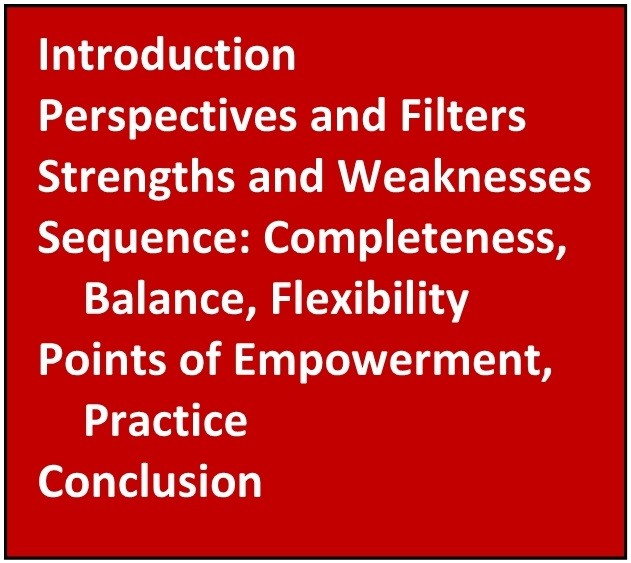
The phrase “seeing the glass half full” or “seeing the glass half empty” (half full/half empty) refers to what a person notices first about a glass half filled with water. People ask, “Which is better, and how should I be?” Should I be a half full or a half empty person? As we explore half full/half empty we hope to discover the use and value of the half empty approach. This is related to the idea that emptiness is something important and has use and value. We will present points of empowerment and a practice that is profound.
We usually mean that a person’s approach to life is seeing life as half full or seeing life as half empty. There is often a judgement and an implied criticism from the half full people that seeing the glass half full is “better” than seeing the glass half empty. The half empty people state that this is the way life is, that they are being “realistic” which is a necessary (maybe better) way to approach life. Despite this statement the half empty people sometimes feel embarrassed and may feel ashamed of their approach.
Here are some examples of categories associated with half full/half empty people.
Glass is Half Full Person Glass is Half Empty Person
- Optimist Pessimist
- Does not complain Complains
- Positive people Negative people
- First impulse—say “Yes” First impulse—say “No”
- Pie in the sky Mary Poppins person Down to earth, see it like it is person
- Assumes the weather will be nice tomorrow Watches the weather looking for rainy days
- Things are ok just the way they are. Nothing is ever good enough.
- Refrigerator is half full, shop next week Refrigerator is half empty, shop today
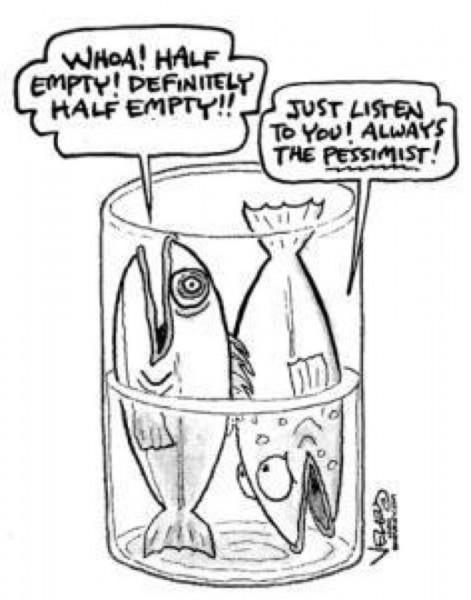
These are generalizations, black and white statements. It is not possible, or desirable, to be a totally half full or half empty person. We are talking about tendencies, the tendency toward noticing first that the glass is half full or is half empty. Life presents us with situations, not glasses of water standing next to each other. In reality somethings things are positive, somethings are negative. Sometimes things are good enough, sometimes they are not. Sometimes things are ok, sometimes they could be better or there could be more.
PERSPECTIVE AND FILTERS
The glass half full/glass half empty is a perspective. A perspective determines how a person sees things. It is a point of view from a certain place and through certain filters. (We can have a point of view from the top of a mountain or from the bottom of the mountain, for example.) Our filters allow some perceptions into our awareness and disallow, sometimes completely block, other perceptions. As a perspective half full/half empty has a profound meaning that can intensely influence a person’s life.
The filter of the half full perspective is to first see what is there and not see the emptiness. The filter of half empty perspective is to first see the emptiness and not see what is there. The half full person may or may not, or may never, see the emptiness. The half empty person may or may not, or may never, see what is there. If the filter is so strong that never seeing the emptiness or fullness occurs then that person only experiences half of life.
STRENGTHS AND WEAKNESS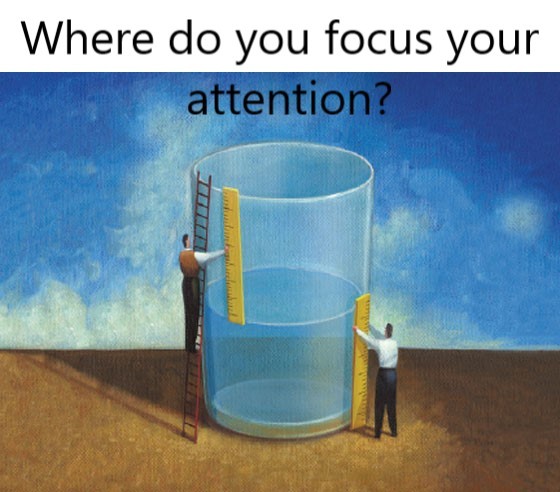
Each approach has strengths and weaknesses, has usefulness and distortions. The strengths of the glass half full approach are to see what is there before us, what exists, “what is immediately present,” and to respond to that perception. It reacts to what could be called the good, the bad, the ugly, and the beautiful of life. Glass half full people are responding to and experiencing what, life presents to us. The weakness of the half full approach is to miss the opportunity to deal with an emptiness that presents us with opportunities to create something new and exciting.
The strengths of the half empty approach are that noticing the emptiness makes it easier to see what is not there, what is missing. In noticing the empty space we can know that there is room for something new to fill the space. We then can create what is missing or something else, something new—being creative and innovative. In addition, half empty people quickly see what problems need to be solved, identifying “what is wrong and why something doesn’t work.”
Point of Empowerment: The glass half empty approach is profoundly necessary as a step toward problem solving, creativity and innovation. Seeing emptiness open us to the realm of infinite possibility.
The weakness of glass half full is that one could just focus on the emptiness—what is missing and get stuck there. One does not look beyond what is missing to the possibilities and potentials for more of what we desire. If we unintentionally get stuck in the emptiness we can become resigned to living a life with less than what is possible.
Another weakness of the half empty approach is to miss what is in the present moment, the pleasure, happiness, joy, or love that is available for us to experience. Also, there is the danger that the half empty approach can become mired in negativity, a negative approach to life. This can be devastatingly unfortunate.
A word about optimism and pessimism. They get attached to the half full/half empty approaches. Optimism says, “I know this is going to turn out well.” While pessimism says, “I know this is going to turn out badly.” Optimists react in a way that has a positive feeling to it. 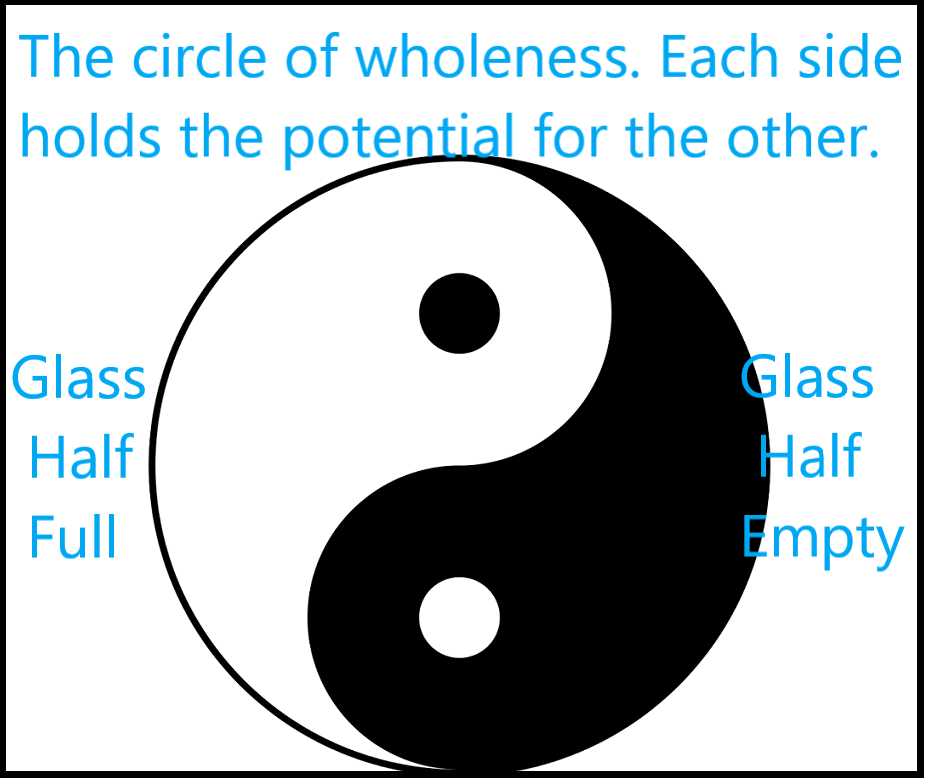 Pessimists react in a way that has a negative feeling to it. Attaching optimism and pessimism to the half full/half empty perspective is a mistake since we need to be optimistic or pessimistic according to circumstances. Some situations are going to go well, while others will go poorly. Effective living requires both.
Pessimists react in a way that has a negative feeling to it. Attaching optimism and pessimism to the half full/half empty perspective is a mistake since we need to be optimistic or pessimistic according to circumstances. Some situations are going to go well, while others will go poorly. Effective living requires both.
THE SEQUENCE: COMPLETENESS, BALANCE, AND FLEXIBILITY
To be all we want to be, do everything we want to do, and have all we want to have, we need to follow a certain sequence of perception and thought that will bring us completeness, balance and flexibility. The sequence is different for half full/half empty but ultimately leads to the same place.
The sequence for the glass half full person is to first notice what is here, respond to it, and then see that something could be missing and consider creating what is missing.
The glass half empty person first notices the emptiness. The next step is to ask, “Is there something here I am not seeing?,” then look for what may have been overlooked. In addition, there is asking, “Is there something that is missing that I can create to fill the emptiness I noticed?” Since there is always fullness and emptiness in every situation, completeness is seeing the whole picture: seeing half full then seeing half empty or seeing half empty then seeing the half full. Completeness has brought us a balanced perspective (seeing both full and empty), and has helped us avoid a one-sided, distorted point of view of life. What exists is experienced and what can be created is considered.
There are situations where seeing what is missing is more important and situations where seeing what is there is more important. The flexibility of half full or half empty is needed to accomplish the most important thing.
Point of Empowerment: What we want is both, the ability to see the glass half full and the ability to see the glass half empty. This creates a balanced life.
Here are some examples of the weaknesses in action along with some possible modifications.
- I know that my spouse has been home today. I walk in and notice what has not been done and make a negative comment about it, never acknowledging what he/she did accomplish. Rather I notice what has not been done, but then look for what has been done or seek to just know what my spouse’s day has been like.
- I see only my friend’s good traits. When he/she insults me I am “deeply hurt” because I have not acknowledged his or her destructive side. Along with good traits, it is useful to acknowledge a friend’s faults to have a more complete view of this person thus recognizing the potential for hurtful behavior.
- I believe what the sales representative says and buy an unnecessary pest control treatment for my home because “people tell the truth.” I have missed the dishonesty that is there. Seeing a person’s hidden agendas allows for self-protection.
- I over focus on a person’s fault’s not seeing his or her good points. I cannot fully appreciate who he or she truly is. Rather, seeing strengths and weakness provides for a complete understanding and a richer appreciation of another person.
- I constantly look at the weather forecast seeing when it will rain and create a gloomy mood for myself. Or, I don’t look at the weather forecast not wanting to see “bad weather coming” and don’t dress appropriately. Instead I look at the weather forecast when I have to plan ahead.
- If think that my friend is doing ok and miss where he needs help. Rather, I see what she is accomplishing and notice where she may need help.
- My son comes home and comments that I have not taken my grandson to the playground. He is not interested in all the other things we did during the day. Rather, he asks what they day has been like.
- I complain about all the drudgery of earning my college degree missing the opportunity to acknowledge my accomplishment. Rather, I mention the drudgery but concentrate on celebrating my accomplishment.
- My spouse greets me at the end of the day and recites a list of all the things that went wrong. The opportunity to acknowledge and celebrate the good things of the day is lost. Rather, the pleasure and pain of the day are both talked about and acknowledged.
- I bought strawberries that are “on sale” and did not see all the rotten ones in the box. Rather, I see the whole box and decide if the money saved is worth it.
POINTS OF EMPOWERMENT, PRACTICE
Let’s consider some profound ideas that arise out of our discussion so far. Let’s remove the labels of good and bad from half full/half empty to see things at a deeper level.
Points of Empowerment:
- Human beings are capable of sensing what is missing, missing in a situation or missing in our lives.
- What is missing exists in emptiness as possibility and potential.
- Freedom exists in the moment of emptiness since we are free to fill that emptiness with whatever we choose.
- We fear emptiness because we have seen that what fills emptiness are our fears.
Practice: Notice when there is an emptiness in the present moment. Allow the emptiness to exist. Don’t rush in to fill the emptiness as this is a moment of possibility, of freedom of choice for what the next present moment will contain. Choose to fill the emptiness with something you want, with something that will enrich your life. If you don’t see emptiness but what is missing stay with what is missing. Look for clues about what to create next then exercise your freedom of choice by creating what you want.
CONCLUSION
We have explored the notions of the glass half full/glass half empty showing the strengths and weakness of each approach. Another weakness of the glass half empty approach to life is that it can make a person vulnerable, put him or her at risk, of becoming “negative,” of living in pervasive and painful negativity. In our next letter (October) we will explore negativity seeing how it starts and how to end it.

